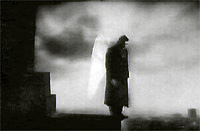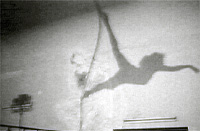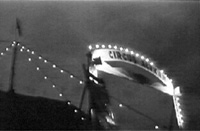|
Wenders had initially wanted Robby Müller as director of photography for
Wings of Desire, but Müller declined because he was engaged at the
time in the filming of Barfly. Veteran cinematographer Henri Alekan, who
had already worked with Wenders as his d.p. for The State of Things
(1981), was then asked by Wenders and accepted the assignment. Born in Paris in 1909, Henri Alekan had participated in the production of a number of masterpieces of French cinema, such as Marcel Carné's Le Quai des Brumes (1938), René Clément's La Bataille du rail (1946), and Jean Cocteau's La Belle et la Bête (1946). Alekan is also the author of an extraordinary book on the nature of light in the cinema and in painting, Des lumières et des ombres, the most recent edition of which was published in Paris in 1991 by la Librairie du Collectionneur. In reference works on film, Alekan is typically described as follows: "He is one of France's most reliable cinematographers, adapting his style to the needs of the script and the director and always capturing the essence of a location" (Ephraïm Katz, The Film Encyclopedia). RR: I noticed in your book a discussion of the shot in which we see Damiel with wings that disappear almost immediately. I assume that this idea - of showing Damiel with wings for a brief moment - was thought of just before the shot was filmed, and obviously after the moment when it was decided that the angels would simply be dressed in overcoats. HA: Yes, I must say that the history of this shot - and not only of this shot but of the fact that the angels have or don't have wings - was a real problem from the earliest preparations for the film in Berlin, where every Sunday evening, I brought Wenders little sketches I had made while visiting museums and where I said to him: "Here is how such-and-such a master painted an angel with wings, like that, while some other 17th or 18th Century master envisioned the wings this way." And Wim listened to me very attentively because he hadn't yet made up his mind at that point. Then one evening he said: "We'll have wings made in Paris, since they can't be done in Berlin, and they'll be made of such and such a substance and we'll try them out." But every passing day brought us closer to the date when the shooting was to begin and one day, we were running out of time and the wings which were in molded plastic, I think, were not very beautiful and couldn't be worn. And you could see at a glance that the wings were just stuck on to a character. Then Wim thought of dressing them in a kind of armor - inspired by the way by a painting - and with wings that were more solid. And that didn't work out either. The days went by. Then all of a sudden, Wim said: "All right, we're not going to have our angels walk around in Berlin with their wings. The wings will disappear right away." So we had been pressed to some degree by the lack of a creation that all audiences would find believable. I agreed with the decision and suggested to Wim that we use a trick effect - one that is actually rather complex - where in a studio, the angels who then were going to wear a large gray overcoat - likely, modern, contemporary - would have wings for a few seconds and then the wings would disappear as if by magic. The trick effect was difficult because it involved a system of mirrors placed before the camera in such a way that and the angel-actor and his double, dressed the same way and standing in another part of the studio, could each be reflected in the mirror . The double wore wings but not the angel-actor. And by means of lighting, the wings were either illuminated or disappeared in the darkness. That is the basic idea of the technique. I had used it forty years earlier in La Belle et la Bête [Beauty and the Beast] and in a number of other films as well, and knew how to make it work. But this time we could use video monitors, so the actor and his double could see themselves. That made it easier to superimpose the two bodies and the wings. But still it took a whole day to get it right. And from that whole day of shooting, Wim kept only a few images of the angel perched at the top of the cathedral. And once the wings disappeared, the film could continue with the angels looking more like humans walking around in the streets of Berlin than like real angels - if there is such a thing as real angels.
RR: I know that you prefer to create effects in the camera rather than turning over to the laboratory the production of effects. I imagine that there are several factors in play in this preference - such as the challenge for you, and the viewer experiencing a greater authenticity in an effect produced in the camera. HA: I think perhaps the word authentic isn't fully appropriate. Maybe it's the fact that the tricks done in the camera are tricks carried out by a person. While tricks done in the laboratory - though obviously also carried out by a person - involve a good bit of science. And there is a difference between scientific, rational thought and artistic, emotional thought. I just don't believe that electronic effects can make the public experience the same communication you can achieve with a trick that is manually executed. The proof is that in the theater, the tricks are almost always done manually. And I think we fully accept the little risks, even the imperfections, that can suddenly turn up in a theatrical trick effect. Cinematic effects are much more advanced, it's true. The public shouldn't realize that we are using an effect. But they have to feel the same emotion as the person who has created the effect. Then you are dealing with people, with grips, gaffers, cameramen, who play with the effect like musicians in an orchestra. A recorded concert doesn't move me in the same way as a concert experienced in a theater and in the presence of the musicians. And I think that trick effects in the cinema work the same way. That's why I always prefer tricks that are invented on the set, manual, of the do-it-yourself variety, rather than tricks that are too calculated, too scientific. This all comes down to a difference of sensibility and emotion. I don't think the special effects we see so perfectly executed in American films touch us as deeply as the simpler effects of the kind we saw in the films of Méliès and which we find enchanting. Because I think the creative artist can communicate more directly with the public by means of tricks done in the studio rather than through special effects of a scientific nature perfectly executed in the laboratory. To me, that is extremely important. That's why I go on, even if it seems a bit old fashioned, using relatively simple tricks, with semi-reflective mirrors, with lights you turn on or off, and which directly transmit to us what the artist feels. RR: In any event, that particular effect was wonderful. HA: Well that's the way I see it. Even for something lasting only the briefest moment, I think we feel something rather magical, rather extraordinary. And it's quite simply a matter of turning on or turning off certain lights which make the wings, that are actually worn by the double and not the angel, either appear or disappear. RR: There are two shots in which we see first Damiel and then Cassiet seated in a convertible, on display in a store selling cars (shots 1048-1049). At the start of each of these shots, the angel is concealed by the reflections of the overhead fluorescent lights in the windshield, and it is only when the camera moves around toward the side of the car that we can finally see the character. Did you know ahead of time that those reflections would be there in the windshield?
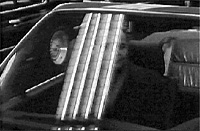
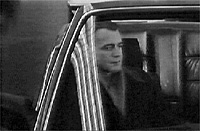 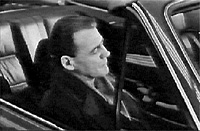
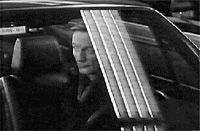
It was cut out during the editing and replaced by another idea that came to me at the time we were rehearsing with the actors and the fluorescent tubes in the ceiling of this store were reflected in the windshield. And out of the blue I said to Wim: "What if we used a little overexposure of the fluorescent lights to hide the faces of the two characters? And since you want a tracking shot from one face to the other, they'll appear behind the reflected fluorescent lights." Wim said "Bravo!" And that's simply what we did - it's not a trick, it was a reality. At one point, the fluorescent lights were stronger than the lighting on the characters. Naturally I had lights illuminating the faces as well. Those lights were turned off at the start of the scene. That's why the fluorescent lights were dominant. And then when the camera began to track, we gradually turned up the lights and the faces appeared behind the windshield. It was spontaneous and unexpected, and that's interesting. Not all directors would go along with something like that. Some would have refused. Most would have refused, at least those of my hayday. Now maybe there is a greater freedom in creation and more receptiveness to last minute suggestions. But at the time when I worked with Duvivier, for example, everything was meticulously calculated in his screenplay. And we followed his instructions to the letter. The same was true of Carné. They were directors from the old school who had been taught to follow a detailed shooting script, shot by shot, and which left no room for imaginative inspiration [on the set]. Fortunately, with Wim - even though he carefully thinks through all of his shots ahead of time - he leaves room for the sudden looming up of unexpected opportunities. That's what he does. RR: Did the scenes shot in the library involve any particular problems? In my experience as a cameraman, it was quite exceptional to have to light up a surface and volumes that were so immense as those in the Berlin library. I was both very impressed and also worried when the decision was made to shoot in that location. My general philosophy is never to argue with the director. I have only done so very rarely. I can't remember ever refusing to shoot any given scene - as certain of my colleagues had. Whatever difficulties were involved, I told myself: "Actually, I'm here to try to effectuate the thought of the director. So let's try to acquiesce to his vision." And Wim wanted this fabulous decor. But with respect to technical matters, it required a lot of equipment. And it was my good fortune to be working for a company that could finance my own needs, which were enormous. Since there was a lot of current needed, a lot of lights, a lot of gaffers to do the installations. Since everything had to be hidden. And in fact, you don't see a single light, despite the fact that there were scores of them set up at the location. And it was difficult because we filmed in the daytime - but since it was winter, at three or four o'clock in the afternoon, it looks light night - we had to take whatever measures we could to prolong the day, even if we continued filming in the same direction as at the start. It was then decided - and this is one of the nice things about working with Wim - that as long as the daylight lasted, we would film in one direction, and when night came, we would change direction, and return a week later (since we could only film there one day a week: on Sunday). So there were in fact immense difficulties. And in the end, I found that these were beneficial constraints, because something good always comes from having constraints. The same is true of painting. Painters who have no constraints don't produce anything extraordinary. I think that in all the arts, these constraints are present. And there are plenty of them in the art of cinema. So I acquiesced to these difficult conditions for shooting, and in the end I was rather happy with the situation. Our profession can be agonizing. Because it is based at the same time on a balance between a certain artistic vision of the thing to be filmed, and technical limitations as to what can be done. Suppose I don't set up lighting, and as some young cameramen sometimes say: "That's the way we'll shoot. The film is very sensitive, and if there are problems, we'll overdevelop it." Those are technical means. But I wouldn't find them satisfying. Because I like it best when there is a personal intervention upon the image. And the ensure this personal intervention, I don't just work with so-called "natural" light. I modify that light. I want to control it. I want it to become a part of my concept of lighting. Therefore, I need to use lights. And I find that with Wim, and this is extremely rare, I am always given a tremendous freedom, no matter how difficult the scenes are to shoot. RR: Was it with respect to the placement of the lights that the actors' movements were subsequently determined in the library scenes? No. First Wim planned the movement. And afterwards we did the lighting. And that's what often opposed me to directors - no, not often, once in a while in my career as cameraman - I have run into directors and especially producers, production managers who wanted me to set up the lighting in the studio or on location before the actors came to rehearse. And it didn't do any good for me to explain that I couldn't set the lighting unless I first see what the action will be. And reading it in the screenplay just isn't the same thing. Something very concrete happens. It's the actors' movement before our eyes, the way they play their parts, their place a space, on a surface, in a volume, which enables us to find the proper lighting. And this proper lighting can only be made very concretely when we have seen what is going to be shot. But when a director, and especially a producer says: "We're not going to wait two hours or three hours for Monsieur X or Mademoiselle Y to arrive. Go ahead. Set up the lights!" I say; "No. I can't set up the lights." Of course, you can place the lights physically, any which way. Well not quite any which way, but depending on the location... But I never turn them on. I don't want to be fooled by a lighting that will probably be acceptable in a purely physical sense, because in this physical respect you need a certain level of illumination for the image to be recorded on film. But it must correspond intimately with what will happen, with the action. And this is the way I have always worked, on every film. First of all, and this is what I tell young people, illuminate the action. Then, illuminate what is secondary. The secondary is the background. The décor. Occasionally, of course, the décor is the main thing. During several seconds, it's the décor that will determine the meaning of the scene that will follow. In such a case, you illuminate the décor. But almost always, if it is the décor you illuminate, it's because the décor has a primordial importance at that moment. In other words, you light it as you experience it. The décor is the star for several seconds. But it is almost always the case that the action supersedes the décor in importance. So you have to imagine layers of lighting which will in turn attribute importance either to the décor or to the actors. And that has been the rule I set for myself for many years and that I would like to pass on to young people. Don't let yourself be distracted, don't let your attention be absorbed by the environment. The environment takes second place. The action comes first. This applies both to the theater and to film. And sometimes maybe even to painting. But it's different in painting because of the fantastic concept of time. The passing of time in film doesn't allow us the same mastery, because the images are ephemeral. The painter's canvas gives time to the viewer, leaves him all the time in the world to examine the work, to explore it and to experience it. He can spend thirty seconds or he can spend two hours in front of a canvas. That can't be done with film. With film, there is a rhythm imposed by the editing and there is the ephemeral nature of the image. So during the minutes or seconds that this fleeting image is on the screen, you have to enable the viewer to see and especially to experience that there is a very rapid emotional shock. So the lighting has to be designed in such a way that its form can pierce through the screen and travel like an arrow into the viewer's mind. RR: There is an extraordinary shot in which the dying man and Damiel are seen frontally. In this shot, the camera tracks back and forth, from left to right several times. Did you discuss these camera movements with Wim Wenders? HA: No. They were determined, I would say, by Wim whose sense of the image is simply marvelous. My sole concern at that time was with the lighting. And he was the eye at the camera. And before turning over the camera to Agnès Godard who was my former assistant and pupil - she had studied at L'IDHEC when I taught there - Wim himself made all those decisions. Afterwards, I stepped in because the shot continues on the bridge and I said: "It would be wonderful if we could continue the shot on a passing train." But no trains were passing by just then. Then an assistant signaled to us from a distance that a train was approaching and the shot involved a camera movement that had to be perfectly coordinated. And finally the train went by and the camera caught it on film. RR: There is another wonderful shot near the end of the film where Marion is performing on a rope and we see the play of her shadow on the wall. Was that shadow planned from the start?
HA: No, it wasn't planned. Some things are planned, others are improvised. Wim Wenders had chosen that location. It wasn't done in a studio, it was a real location. And I thought I would use a kind of lighting called zenithal, which comes from high above and falls vertically downward. Then it turned out that the available light interfered somewhat with my original intention [...] I added artificial light and proposed to Wim that we play with Solveig's shadow on the walls. And I think that worked out fairly well.[...] RR: During the filming of Wings of Desire, did you shoot relatively few takes of each shot? HA: Yes, except for difficult things. Solveig on the trapeze when sometimes a move didn't work out as planned. Then we did the shot over and over again. But Wim never went overboard with excessive numbers of takes. Three or four takes and he was satisfied. Some years ago, there were directors - I will cite one example since it was so extraordinary: Bresson, who wanted 17 takes, 20 takes, 30 takes! My chief gaffer, who I think made two films with Bresson, was a witness. And he told me: it's incredible, we couldn't understand how he would be able to make a choice later on, with all that footage. No, people are more sensible now because it's often enough for the actors to rehearse beforehand. Some directors don't go along with that. They want the actors to keep their spontaneity and the instantaneousness of the moment, so they avoid rehearsals. And I think that often they are right to do so. Because the limited experience I myself have had as an actor has taught me that in the two or three films in which I've had a small part, I was incapable of rehearsing. What comes the first time can be improved in one or two takes, and after that you feel that it becomes mechanical and lifeless. Many directors nowadays have rightly understood that it is important not to exhaust their actors and they therefore value spontaneity and the inspiration of the initial moment. RR: I think I have read somewhere that the takes for Wings of Desire were relatively long. Does that correspond to your recollection of the shooting? HA: Very much so. They were often extremely long. That's Wim's method. I think he likes to have a great deal of footage in order to have a free hand during editing. He has a wonderful editor - Przygodda - who has such a great sense of rhythm that Wim Wenders never works without him. RR: Did you make sketches for many of the scenes? Yes, but not always. I make sketches when I need to work things out, when I don't know ahead of time how things will be done. With Wim, two or three times, I made sketches that were useful, I think, because I could show them to him and ask: do you agree that I should go for such-and-such a main effect and such-and-such a secondary effect. Then there was the case of the bunker where it was fully calculated; it was like a studio, completely dark. And I said to myself: all right, let's imagine that the roof is caved in and that light falls from floor to floor to the very bottom, across - which was true - the beginnings of the demolition of the various levels. Obviously, this could have been done in other ways as well. When I look at my photos of the location, I think: maybe I could have designed things differently. Perhaps I could have produced something more mysterious, more dramatic, more in half-light. But that was the way I did it. Especially when I think back to the era of German expressionism in 1920, with rather high contrasts, hard shadows and bright surfaces. The word expressionism was spoken and Wim said to me: all right, I agree... And obviously, once you decide on a given kind of lighting, you have to stick to it throughout the sequence. And it required a great deal of equipment, a lot of work to place the lights that had to be installed in this difficult location. But on the whole, I think it worked out pretty well. And the other occasion when sketches I made were important because they determined how we would shoot the scene, was towards the end of the film when the action is set in a night club in Berlin. Again there was a problem. There was nothing there. We were in a fake night club reinvented by the set designer, but not in a studio. You know, it's always harder when you're not in a studio. There are no scaffolds, no facilities. And the location, set up with its little band stand and the place where people could dance - I had to wrack my brains asking myself: how should this be lit? Then suddenly I thought of something that could give some unity to the lighting, and I said to Wim: what if we imagined that the light comes in from outside this darkened location through a large, square door? Because I rather like light that is well defined. And he said yes. So I imagined that the principal source of light came from the exterior to the interior artificially, since we shot at night. And also that there would be a special illumination on the musicians and a few lighting effects - not too much in the style often seen on television where we are supposed to be continually dazzled by dancing spots of light- but a little bit, as can be found in a night club, to punctuate the music. A few blue and orange effects, and nothing more. It had to be rather discrete. And then the entire sequence was dictated by this concern with seeing the faces of the spectators, the dancers, slightly illuminated by the changing reflections of the colors. And then the entrance with a great horizontal light... I made a sketch and showed it to Wim. He said: "All right, go ahead Alekan." And that's the way it began. So once again, this shows the complicity that must exist between director and director of photography. If that complicity isn't there, the work becomes insipid. And that's too bad. I must say that throughout my career, I generally had that good relationship, as was the case with Julien Duvivier when I filmed Anna Karenina. That is probably one of the films about which I am most proud of having done the cinematography and about which I have fond memories of having worked with a great director. Naturally, I can also mention Abel Gance. It was different with Gance. Or Marcel Carné. And especially Yves Allégret. I loved working with Yves Allégret. Of the one hundred and fifty films I have made, there are only about ten or twelve that remain really salient. [...] RR: In naming the circus "Cirque Alekan," Wim Wenders was clearly paying homage to you. But is there a deeper meaning to this connection? Was it a way of saying that making a film is also in itself a kind of spectacle?
HA: I can't really answer your question very precisely. You'd have to ask Wim Wenders about that. All I can tell you is what I remember of this matter. From out of the blue, Wim said to me - at the start of the circus shoot - "Every circus has a name. Would it be all right with you, Alekan, if I gave your name to the circus? That took me by surprise. I was delighted and answered, why not? And clearly, I think it was a way of paying homage to me, since it happened again in the sequel [Far Away So Near], in which he named the barge "Alekahn". RR: But why did he add the "h"? HA: Because it turns out, I believe, that [kahn] means "barge" in German. RR: You mentioned a while ago that Wings of Desire is a film you like very much. Could you state in a few words what it is that appeals to you most in the film? HA: The subject seemed to me quite original in relation to what is made today in the cinema and on television. This overview of human activity on the earth through the intermediary of the two angels. The reflections that the angels exchange. And the adventure of an angel who, because of love, wants to become a mortal. I found that absolutely splendid. Because, in the end, what Wim brought out was how much the relations between man and woman, how much love, friendship and brotherhood count. And everything is made concrete by this character who in the end - even if a heavenly life is something wonderful - prefers to become a mortal and to live like any ordinary person the joys and the passion of love. Parly, 7 August 1993 [1]This interview was published in French and under the title "Si tant est qu'il existe des anges réels" in (Pré)publications 141 (November 1993), pp. 41-58. The present translation is my own.
|
